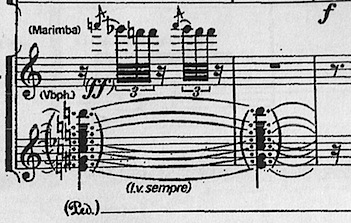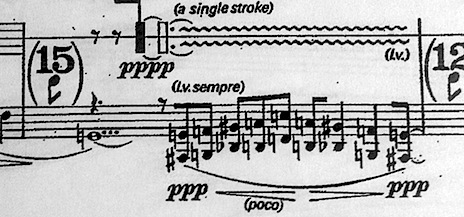Page 1 of 3
Crumb's unique rhythms
Posted: 22 Dec 2015, 11:01
by OCTO
Yesterday I was serving as a producer on recording of Crumb's Quest.
Interesting notations: in both cases there are note-values that cover the whole measure, impossible in the traditional notation.
First, a dot on the opposite side, in
5 / 
:

- 20151221_193751-1.jpg (45.46 KiB) Viewed 13519 times
Second, multiple dots in
15 / 

- 20151221_202051-1.jpg (53.09 KiB) Viewed 13519 times
Re: Crumb's unique rhythms
Posted: 22 Dec 2015, 16:37
by wess-music
First one I find very cool!
OCTO, you make me smile! Sincerely.
Thank you.
Re: Crumb's unique rhythms
Posted: 22 Dec 2015, 16:55
by David Ward
Triple dots can be found in Bruckner, although always followed in the bar by the short note to even things up. Usually a triple-dotted minim (1/2) = one and 7/8 minim, followed by a semiquaver (1/16) = the remaining 1/8 of the minim &c.
Crumb seems to be following the same principle with his triple dots after the note, but without the following short note because of his 15/x time signature.
Re: Crumb's unique rhythms
Posted: 22 Dec 2015, 17:11
by John Ruggero
OMG! He's adding on one side of the chord and subtracting on the other. Only Crumb would come up with this.
I've never seen the bracket-like beaming at the end of the second example before. This is a very creative and interesting way to show a syncopation. Is this common now?
The triple dots of the second example are not common, but Chopin has a few and probably many others too. But I have never seen one fill out a whole measure before. If Zeno had been a musician, his paradox would have read "How many dots must one add to a single half note to fill a complete 4/4 measure."
A good case could be made for a new kind of note that fills out an entire measure of any meter, corresponding to a "whole measure rest".
Re: Crumb's unique rhythms
Posted: 22 Dec 2015, 17:13
by David Ward
John Ruggero wrote:A good case could be made for a new kind of note that fills out an entire measure of any meter, corresponding to a "whole measure rest".
Definitely.
Re: Crumb's unique rhythms
Posted: 22 Dec 2015, 18:38
by John Ruggero
But why not:

- l. v. Chord.jpg (21.95 KiB) Viewed 13495 times
In the second example, make it a whole note with a tie with or without an l. v. and everyone will understand. Or make it a double whole note. Will anyone complain?
Re: Crumb's unique rhythms
Posted: 22 Dec 2015, 19:09
by David Ward
That might work for pianists, but what about some notation that would be clear in single line orchestral parts as “a new kind of note …” as you suggested above?
Re: Crumb's unique rhythms
Posted: 22 Dec 2015, 19:22
by MJCube
John wrote:He's adding on one side of the chord and subtracting on the other.
Brilliant!! And why did I never think of this? It’s compact, perfectly clear, and the principle could be extensible to other durations.
Re: Crumb's unique rhythms
Posted: 22 Dec 2015, 19:28
by RMK
Keep in mind that Crumb worked as a copyist for quite a while. His autography is beautiful - suitable for framing.
The music isn't bad, either...
Re: Crumb's unique rhythms
Posted: 22 Dec 2015, 22:26
by David Ward
John Ruggero wrote:Or make it a double whole note. Will anyone complain?
A breve (ie double whole note) is perhaps the most traditional-seeming answer that ought to fit most situations, if not as elegant as Crumb's before & after (or multiple) dots.
 :
: